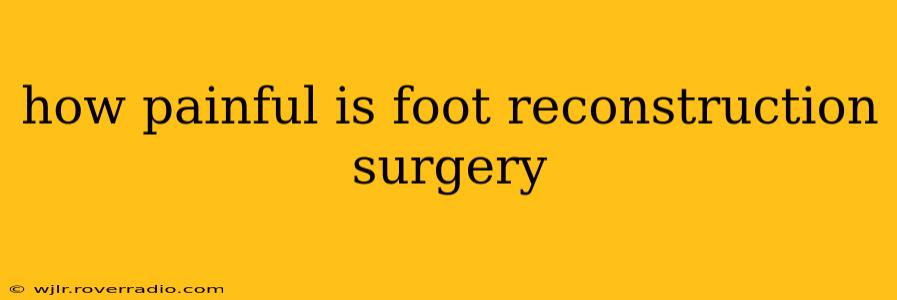Foot reconstruction surgery encompasses a wide range of procedures, each with its own level of invasiveness and associated pain. There's no single answer to how painful it is, as the experience varies significantly depending on the specific procedure, the individual's pain tolerance, and the post-operative care received. However, we can explore the factors influencing pain levels and what to expect during recovery.
What Factors Influence Pain Levels After Foot Reconstruction Surgery?
Several factors contribute to the pain experienced after foot reconstruction surgery:
-
Type of surgery: A simple bunionectomy will likely result in less pain than a complex procedure like ankle fusion or a Charcot foot reconstruction. More extensive procedures involving more bone work, tendon transfers, or implant placement generally lead to more post-operative pain.
-
Extent of tissue damage: The amount of tissue trauma during the surgery directly impacts post-operative pain. More extensive tissue dissection and manipulation will generally lead to greater pain.
-
Individual pain tolerance: People experience pain differently. What one person finds excruciating, another might consider manageable. Previous experiences with pain and individual psychological factors also play a role.
-
Post-operative care: Proper pain management strategies, including medication, physical therapy, and elevation, are crucial in minimizing pain and promoting healing. Following the surgeon's instructions meticulously is essential.
-
Presence of pre-existing conditions: Conditions like arthritis, diabetes, or nerve damage can affect pain perception and healing, potentially increasing post-operative pain.
What Can I Expect During Recovery?
Pain after foot reconstruction surgery is usually managed with a combination of medication (often opioids initially, transitioning to less potent analgesics as healing progresses), ice packs, elevation, and physical therapy. The intensity and duration of pain vary widely:
-
Immediate Post-Op: Expect significant pain in the immediate postoperative period. This is typically well-controlled with prescribed medication.
-
Early Recovery (Weeks 1-4): Pain gradually diminishes, but some discomfort is normal. The focus is on managing pain, preventing complications, and starting gentle range-of-motion exercises.
-
Later Recovery (Weeks 4-12+): Pain continues to decrease, but full recovery can take several months or even longer, depending on the complexity of the surgery. Physical therapy plays a crucial role in restoring strength and function.
How is Pain Managed After Foot Reconstruction Surgery?
Pain management is a critical aspect of post-operative care. Your surgeon and pain management specialist will work collaboratively to develop a personalized plan. This typically includes:
-
Prescription Medications: Opioids may be prescribed initially for severe pain, gradually tapering off as pain subsides. Non-steroidal anti-inflammatory drugs (NSAIDs) and other analgesics are also commonly used.
-
Ice Therapy: Applying ice packs to the surgical site can help reduce swelling and pain.
-
Elevation: Keeping the foot elevated helps reduce swelling and minimizes discomfort.
-
Physical Therapy: A physical therapist will guide you through a program of exercises designed to improve range of motion, strength, and function.
-
Nerve Blocks: In some cases, nerve blocks might be administered to provide more extensive pain relief, especially in the immediate post-operative period.
What are the Long-Term Pain Implications?
Most patients experience a significant reduction in pain after foot reconstruction surgery, often finding the relief outweighs the temporary discomfort. However, some individuals might experience persistent pain, although this is less common with proper post-operative care and rehabilitation. Chronic pain after foot surgery can be managed with various strategies, including ongoing physical therapy, medication, and potentially other interventional procedures.
Is Foot Reconstruction Surgery Always Necessary?
Foot reconstruction surgery is not always necessary. Conservative treatments, such as physical therapy, medication, orthotics, and lifestyle modifications, are often attempted first. Surgery is typically considered when conservative treatments fail to provide adequate relief or when a significant deformity or structural problem requires surgical intervention.
Disclaimer: This information is for educational purposes only and does not constitute medical advice. Always consult with a qualified healthcare professional for diagnosis and treatment of any medical condition. The specifics of your experience will depend on your individual circumstances and the nature of your surgery.
